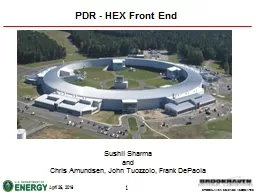

and Chris Amundsen John Tuozzolo Frank DePaola Outline Requirements Specifications amp Interfaces Ray tracings Storage ring modifications HEX front e nd l ayout Preliminary design of the fixed ID: 725893
Download Presentation The PPT/PDF document "PDR - HEX Front End Sushil Sharma" is the property of its rightful owner. Permission is granted to download and print the materials on this web site for personal, non-commercial use only, and to display it on your personal computer provided you do not modify the materials and that you retain all copyright notices contained in the materials. By downloading content from our website, you accept the terms of this agreement.
Slide1
PDR - HEX Front End
Sushil Sharma
and
Chris Amundsen, John Tuozzolo, Frank DePaolaSlide2
Outline
Requirements, Specifications & Interfaces
Ray tracings
Storage ring modifications
HEX front
e
nd
l
ayout
Preliminary design of the fixed
a
perture
m
ask
Preliminary design of the slits
Other
f
ront end components
Summary & ConclusionsSlide3
Requirements, Specifications & Interfaces
Optimized requirements to minimize impact on storage ring
Synchrotron fan from the SCW source is wider than those from previous devices.
First front end with 3 beams.
Version 2 – March 2018Slide4
Beamline
HEX
Type
SCW
Device envelope length
~1.8 m
Magnetic Length
1.2m nominal
(29 main and 4 partial poles)
CantedNoPeriod: nominal70 mmNominal (minimum) gap of vacuum bore tube *10 mm TBCPeak field nominal4.3 T Keff: nominal28.1*1Energy Range: 8 keV –200 keVPower total: nominal 55.7 kW*1Max.power per unit solid angle: nominal28.4 kW/mr2 *1 StraightLow betaDevice center*2May be offset in the straight to the downstream end.Fan angle *3 (mrad H) : nominal (maximum)9.87 (10.15)Fan angle *3 (mrad V) : nominal (maximum)0.88 (1.47)Magnetic field variation rangeCurrent adjustment 0 – 100%
Source Specifications
Beams: Fans and Separations
HEX RSISlide5
Horizontal Ray Tracing – Interlocked Fan (EPS)
Interlocked Fan:
± 0.5 mm
± 0.25 mrad
BeamSlide6
Interlocked Fan:
± 0.5 mm
± 0.25 mrad
Vertical Raytracing – Interlocked Fan (EPS)
BeamSlide7
Horizontal Raytracing – No Interlocks (PPS)
BeamSlide8
Storage Ring (SR) Modification
Modifications to the dipole vacuum chamber is required.
A new design of the SR Exit Absorber is required.
Preliminary SR Ray Trace
Courtesy of C. Hetzel
Dipole Chamber
Exit Absorber
BeamSlide9
Bending Magnet
Photon Shutter
Slow
Gate Valve
Fixed Aperture
Mask
Slits
Photon
Shutter
Lead Collimator-1Lead Collimator-2Ratchet WallCollimatorDual Safety ShuttersFast Gate ValveIon PumpWith TSP (3)BeamHEX Front End ComponentsSlide10
Layout of the HEX Frontend
BeamSlide11
HEX Fixed Aperture Mask
SST Mask of the New Design
The new design concept (beam is intercepted only by top and bottom water-cooled surfaces) allows 3 closely-spaced apertures.
The front end components are made from CuCrZr.
A mask of this design is installed in the SST front end.Slide12
HEX Fixed Mask with Three Apertures
3 AperturesSlide13
HEX Fixed Mask Analysis
Finite Element Analysis Results:
Courtesy: S. O’Hara
A Maximum temperature of 317
⁰C is calculated which is lower than the allowed value of 350 ⁰C.
M
ask with 3 apertures
Max. Power Density:
28.4 kW/mr²
Total Power: 55.7 kWCourtesy: O. ChubarHEX SCW Power DistributionSlide14
Center and
Inboard Beams
Outboard
Beam
Center Beam
Apertures
HEX Slits
The slit design presented at CDR , in which each beam had its own vacuum flanges, was difficult to implement for the closely-spaced beams.
Only discrete apertures are possible.
In the new design the three beams pass through common 8-inch flanges.Cooling channels and apertures are optimized.Slide15
Cooling Channels
HEX Slits
Channel PlugSlide16
HEX Slit Finite Element Analysis
The maximum temperature rise for nominal operating conditions (cases 1,2 and 3) is 250.6
⁰C. This is lower than the design specification of 325 ⁰C.
For the fault condition (Case 4) the maximum temperature rise (357.9
⁰
C) is within the allowed limit (400 ⁰C).
357.9
⁰C
250.6
⁰C99.5 ⁰C221.3 ⁰C1423Slide17
HEX Lead Collimators 1 and 2
Lead Cover Off
With Lead Cover
Lead Collimator 1
Lead Collimator 2
Typical Lead Stacking DetailsSlide18
HEX Photon Shutter
Beam Intercepting Tapered Surface
Photon Shutter (3 Beams)Slide19
HEX Safety Shutters
Lead Cover Off
Lead Cover on
The shutters are actuated by air thrusters that
lower
the lead blocks into the beam path.Slide20
HEX Front End Schedule
Activity
Start
Finish
Layout
& Basic Component Design
01-Nov-17
30-Mar-18Ray Tracings02-Apr-1829-Jun-18
Slit and Stage Design, Prototype and Test
02-Jul-1824-Oct-18Detail Components & Final Design02-Jul-1824-Oct-18Dipole Chamber & Vacuum Design31-Jul-1824-Oct-18Formal Design Review25-Oct-1826-Oct-18Procurement of Basic Components23-Nov-2022-Mar-21Slide21
Summary & Conclusions
HEX
front end layout has been updated for the new RSI.
Preliminary ray tracings have been completed.
Preliminary designs of the front end components have been completed.
A new design of the HEX slits has been developed to accommodate closely-spaced beams.
Detailed finite element analyses have been carried out for the fixed mask and the slits to verify their designs.
Front end design tasks are on schedule.